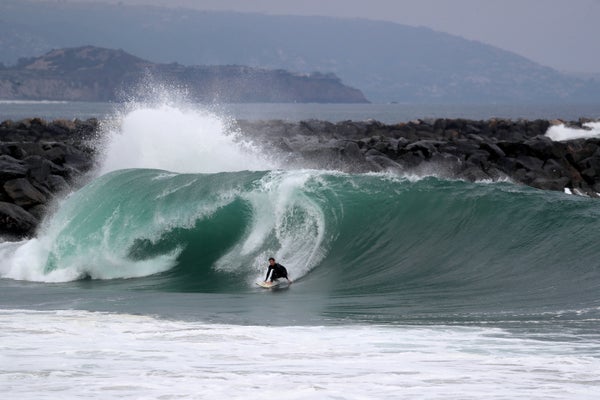CLIMATEWIRE | California beaches, revered for their swells, are a destination for surfers worldwide. But the gnarly waves along the coastline are growing bigger — and potentially more dangerous — as temperatures rise.
A new study, published Tuesday in the Journal of Geophysical Research: Oceans, finds that average winter wave heights have grown by as much as a foot in the last 50 years. And between 1996 and 2016, the number of extreme wave events — when they are taller than 13 feet — doubled from the period between 1949 to 1969.
That’s because the Pacific Ocean is growing stormier as the planet warms, the researchers wrote. And it’s worsened significantly since 1970.
On supporting science journalism
If you're enjoying this article, consider supporting our award-winning journalism by subscribing. By purchasing a subscription you are helping to ensure the future of impactful stories about the discoveries and ideas shaping our world today.
Until now, it’s been difficult to evaluate long-term changes in California waves. Scientists have only been collecting direct measurements of wave heights since the 1980s, by using ocean buoys scattered along the coastline.
But study author Peter Bromirski, a scientist with the Scripps Institution of Oceanography at the University of California, San Diego, came up with an alternative way to measure the swells. Waves produce seismic signals when they slam into the shoreline. So Bromirski compiled seismic records from the California coast dating back to the 1930s, then used them to estimate the size of the waves.
Before 1970, there was a lot more variability in the size of California’s winter waves, he found. There were some extremes, but also plenty of periods with low wave activity.
That all changed in the last five decades.
Bromirski found that there have been fewer low-activity periods since 1970 — and more high extremes and generally bigger waves.
The shift coincides with an overall acceleration in global warming beginning around 1970, Bromirski points out. It also comes amid a general increase in Pacific storminess.
Pacific storms tend to be influenced by a semi-permanent low-pressure system that sits off the coast of Alaska, known as the Aleutian Low. Bromirski found that the Aleutian Low has intensified since 1970, suggesting that increased storm activity is likely driving the bigger waves.
Bigger waves can be more destructive. But that’s not the only cause for concern. Sea levels are also rising all over the world, including along the California coastline.
According to a recent report from California’s Coastal Commission, sea levels there have already risen by about 8 inches in the last 100 years. Future sea-level rise depends on how quickly the world reduces greenhouse gas emissions, but it could be on the order of several feet by the end of the century.
Rising seas boost the impact of waves on the shoreline, making them more damaging, Bromirski warned.
“If Pacific storms and the waves they produce keep intensifying as climate change progresses and sea-level rises, it creates a new dimension that needs to be considered in terms of trying to anticipate coastal impacts in California,” he said in a statement.
Reprinted from E&E News with permission from POLITICO, LLC. Copyright 2023. E&E News provides essential news for energy and environment professionals.
